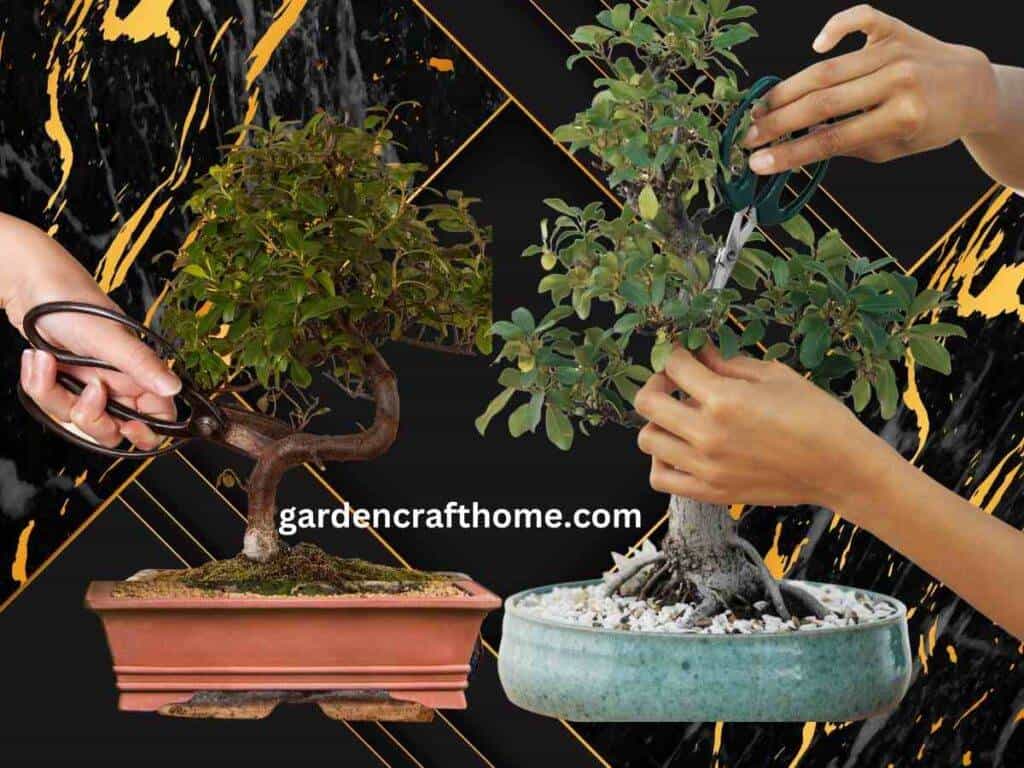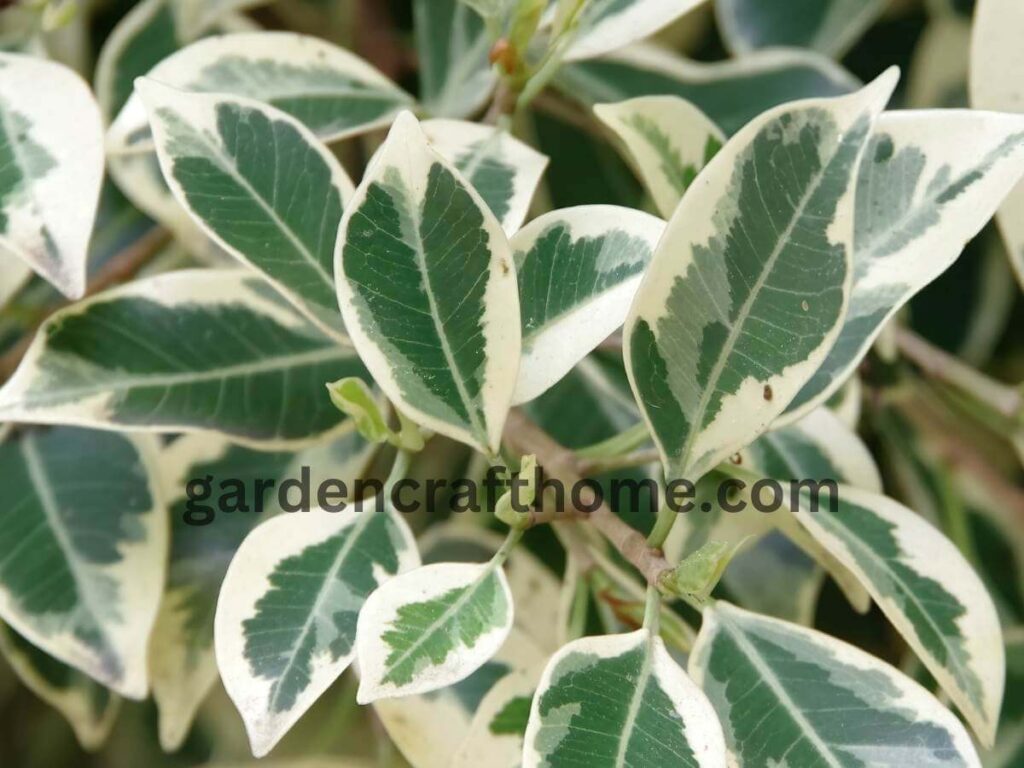How to prune a bonsai tree? We prune a bonsai tree using sharp and sterilized pruning shears to cut off the outgrown branches, leaves, roots, and Dead branches.
Pruning a bonsai tree is an essential technique to maintain its shape and promote its health. Also, read the basic techniques needed for bonsai art.
Bonsai pruning helps to maintain a small size of bonsai tree. Remember, Bonsai is not a particular tree but a way of cultivating trees into small sizes.
Since pruning a Bonsai tree is one of the best ways to take care of it, I also have an article about how to take care of a Bonsai tree. Read it now.
But how to prune Bonsai? Let’s find out below the techniques and the steps to follow.
What Tools Do I Need To Prune A Bonsai Tree
A sharp and sterilized pruning shears like;
scissors, twig shears, or
bonsai tongs.
What Are The Types Of Bonsai Tree Pruning?
When asking how to prune a bonsai tree, remember that Bonsai pruning is divided into Structural pruning and maintenance pruning.
The maintenance pruning is the act of maintaining, renewing, and refining an existing bonsai tree shape.
Structural bonsai pruning is the act of giving a Bonsai tree a new shape and structure.
Both types are essential to give the Bonsai the desired shape and to maintain this shape in the long term.
Bonsai Structural Pruning
The bonsai structural pruning is a pattern and stylistic way to form a bonsai tree to a desired shape (bonsai style).
The quality of bonsais changes and improves fundamentally from an aesthetic point of view.
Structural pruning is more radical than maintenance cutting and requires more knowledge and preparation.
Structural cutting is mainly done at the beginning of a bonsai’s development.
As a result, an original plant or an existing pre bonsai is completely overhauled. Thus, its shape is significantly changed.
Maintenance Bonsai Pruning
Maintenance bonsai pruning or maintenance cutting involves maintaining the specified style of a bonsai and improving the existing shape qualitatively in many small steps.
Bonsai pruning is generally understood as maintenance bonsai pruning. It is less drastic and should be done regularly for deciduous trees, about 2-3 times a year.
Deciduous trees like Metasequoia Bonsai, Maple Bonsai, Apple Tree, Privet, Ficus Bonsai, Hornbeam, Serissa Bonsai, Linden
Euonymus, Pepper Tree, elm bonsai, less often for conifers, e.g., 1-2 times in larches and one time for white pine bonsai,
juniper bonsai, podocarp, as otherwise, the quality of a bonsai tree can quickly deteriorate.
Also, read how to fertilize a Bonsai tree correctly.
What Does Bonsai Pruning Consist Of?
It consists of aggressively cutting the trunk to prevent the tree from continuing to grow apically and to encourage lateral branching.
Most species tend to apical growth; most of their efforts and energy are directed to the apex to grow in height.
In Bonsai, we need the opposite: to oppose that apical growth and give vigor to the lateral branches that are sometimes the lowest.
How Is The Technique Performed?
How to prune a bonsai tree: Once we have chosen the height at which we want to cut, we will make sure to have a branch that can replace the apex we will cut. It defines the exact place where we can cut.
The cut should always be made beveled, with the new apex at the tip and the surface of the cut pointing towards the back of the tree.
With that branch, we will build the new apex; the cut must always be made at a height lower than the desired height for the future Bonsai.
The apex is the “engine” of a tree’s development. Its growth is what fattens the trunk the most.
Since it constantly seeks to increase in height to achieve a better position for capturing the sun.
To do this, it develops its basal structures and tissues to give it sufficient support to support it.
An intermediate technique that we use to continue fattening the Bonsai and control natural growth is the replacement of the apex.
We are eliminating the original apex and choosing a branch in a suitable position so that the tree itself then designates it as the new “engine.”
It would help if you were pruned again and replaced every one or two years with another replacement branch.
Otherwise, we will lose control as the one that initially replaced the apex takes on too much vigor.
I have written an article to show you how to make your Bonsai grow fat or more significant. If you’re interested, read it now by clicking here.
When To Prune A Bonsai
How to prune a bonsai tree: Generally, the best time to prune is during the fall until the end of winter.
It will depend on the species and the magnitude of the pruning that we want to carry out. However, you can prune most bonsai species throughout the year.
To choose the ideal moment on that date, since some trees allow us to make large cuts during the autumn.
Others are better to do them at the end of winter so that the spring awakening is favored—the healing.
Once again, we must review the file for our species and variety to clarify that information.
It would be advisable to do soft pruning of finer branches during the fall. If you will cut thicker branches, wait until late winter to prune them.
Since those branches are where the tree will accumulate energy to resist winter and sprout,
If you cut them in spring, you will weaken them, endangering their health.
One of the best moments to carry out a severe pruning of our Bonsai is when we transplant it.
Since we will also cut roots, we will balance the force if we do it in a similar proportion.
Also, read how to transplant a bonsai tree by clicking here.
How To Prune A Bonsai Tree Step By Step
How To Prune A Bonsai Tree Step 1;
Before you start pruning, place your bonsai tree on a revolving table if possible, which allows us to observe it well in all its parts.
How To Prune A Bonsai Tree Step 2;
Sterilize your pruning tools to avoid spreading diseases to your bonsai plant.
It applies to all types of pruning, whether branches, leave or shoot running, etc.
How To Prune A Bonsai Tree Step 3:
Choose which branches to remove and decide the shape you want to give to your bonsai tree.
It would be best if you looked at the tree calmly. Be clear about the design you want to give it to remove possible dry branches with scissors.
I highly recommend you Select the branches that hinder the entry of sunlight and eliminate those branches.
Those branches always grow in the wrong direction, and branches that are too large or thick.
If a branch does not fit the shape you want to give the Bonsai, prune it and shape it to your choice, as I always recommend.
Read how to select a Bonsai tree for beginners by clicking here
How To Prune A Bonsai Tree Step 4:
How to prune a bonsai tree: We use a clean, sterilized, and sharp concave branch pruner to prune out dead and unwanted branches.
After cutting those branches, you should not let the cut remain open; we can seal it with glue, paste, or sealant.
When we have covered it, the Bonsai should heal without problems.
Below are the general rules and guidelines for pruning a bonsai tree to know the area to prune.
How To Prune A Bonsai Tree General Rules And Guidelines
There is no specific style of how to prune a bonsai tree. You can give your bonsai tree the best style if it suits your needs.
You can follow certain patterns when selecting which branches to prune. Apart from those that you consider are not valid.
There are certain branches that, according to the bonsai guidelines, are defective, and you should eliminate them if you cannot correct them using wiring:
Read how to wire a bonsai tree correctly: read now
Below are some helpful rules that can help you know how to prune a bonsai tree
· You shouldn’t have two branches at the same height, so you have to select the one you want to keep and remove the others.
· Beware of radial branches, as these can encourage bulges. Select one of them and cut the rest.
· Eliminate branches that grow vertically.
· Remove branches whose curves and movements are unnatural.
· Cut inverted growth branches (which are thinner at the base than at the tip)
· Eliminate intersecting branches.
· Prune the branches that grow towards the trunk.
· Frontal rami is also called the eye-pricking rami.
As a general rule, the more branches you cut, the denser the tree will be when it sprouts again. Normally, the branches in the upper part should be cut more than the lower ones.
However, if the species to be pruned is one of those with a stronger lower part (azaleas, for example, grow more vigorously in the lower part),
We will prune hard in the lower part. And we must cut in its apical zone with moderation since we could weaken it.
It is better to use pruners with a concave cut for the thick branches we will eliminate since it will favor the speed of healing.
If we do a partial pruning that does not cut the entire branch, we must make the cuts diagonally with the cut facing up so that the wound heals sooner.
We must cover the wounds with sealing paste or healing balm to promote healing and protect the tree from diseases and parasites.
Tips For Pruning A Bonsai Tree
· Do not remove more than 30% of the branches.
· Only Cut if you are sure. It is easier to wait and prune later than to cut with doubts and realize later that you needed that branch and not know if one will come out again at that point.
· Keep your pruning tools clean and sharp.
Reasons For Pruning A Bonsai Tree
How to prune a bonsai tree: There are different reasons why we will prune our plant, and we will see that some are similar to those of pinching since pinching could be said to be “light pruning”:
· We will prune branches to clarify areas and allow the sun to reach the interior parts of the tree.
· Encourage branching.
· Distribute the vigor and strength of the tree.
· Design our Bonsai. We will shape and design our tree with this technique and the wire. Bonsai enthusiasts design spectacular trees using only pruning without using a single wire in their Bonsai.
Maintenance pruning removes stubborn branches, leaves, or shoots that grow in unwanted places.
On the other hand, structure pruning involves shaping the tree and removing large branches to encourage the growth of new, smaller branches.
As a general rule, you should avoid pruning more than 30% of a bonsai’s leaves in a single session, as this can weaken the tree.
It is preferable to carry out soft and progressive pruning so as not to put your health at risk.
Once the pruning has been completed, caring for and maintaining the Bonsai is important.
It means watering it properly, providing the right amount of light and fertilizer, and protecting it from diseases and pests.
Learn How to fertilize a bonsai tree.
How To Prune A Bonsai Tree: Frequently Asked Questions
How To Prune A Bonsai Tree: When Should I Prune My Bonsai?
Pruning a bonsai is an important task to maintain its health and beauty.
There are different techniques and appropriate moments to carry out this work, according to the particular needs of each tree and time.
First, we must consider the right time to prune our bonsai tree, which can vary according to the bonsai species.
In general, we prune Bonsai throughout the spring since the trees are in full bloom at this time.
Pruning a bonsai tree in the spring is done specifically for outdoor Bonsai. Still, indoor Bonsai may withstand trimming all year.
However, some species are clipped in the fall or winter. It is critical to examine and understand the peculiarities of each tree to carry out the method at the appropriate moment.
What Happens If I Don’t Prune My Bonsai Tree?
The main problem that can arise if a bonsai is not pruned is that the branches and leaves can grow uncontrollably, unbalancing the aesthetic harmony of the tree.
In addition, an excess of branches and leaves can reduce air circulation and the entry of light, harming the health of the Bonsai.
Another problem that can arise from not pruning a bonsai is that the roots can overgrow and deplete the nutrients in the substrate.
It can weaken the tree and make it more prone to diseases and pests.
If proper pruning is not done, the Bonsai can grow too large and lose its characteristic shape.
Pruning is also important for developing quality branches and leaves in a bonsai.
Pruning a bonsai tree stimulates the growth of new branches and healthier and stronger leaves.
In addition, selective pruning allows the tree to be shaped, highlighting its natural beauty.
Choosing the wrong Bonsai as a beginner can end up giving you issues. They are Bonsai that require minimal effort and care as a beginner.
Read the best Bonsai for beginners with minimal effort; read now.
Conclusion
Now you know how to prune a bonsai tree. Pruning a bonsai is an important technique to maintain its beauty and shape.
We must prune the bonsai tree at the right time, which is the spring season, with the right tools and following the right techniques.
In addition, if pruning is not carried out, Bonsai can suffer from health problems and fail to develop quality branches and leaves.
Remember: Never prune a weak tree.
Useful article





